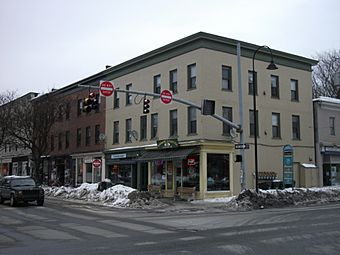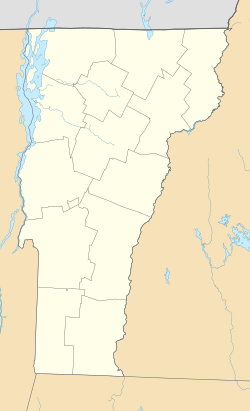Pearl Street Historic District (Burlington, Vermont) facts for kids
Quick facts for kids |
|
|
Pearl Street Historic District
|
|
 |
|
| Location | Roughly 184 to 415 Pearl St., Orchard Terr., and Winooski Ave., Burlington, Vermont |
|---|---|
| Area | 22 acres (8.9 ha) |
| Architect | Cumins, A. S.; et al. |
| Architectural style | Colonial Revival, Late Victorian, Federal |
| NRHP reference No. | 84000416 |
| Added to NRHP | November 1, 1984 |
The Pearl Street Historic District in Burlington, Vermont is a special part of the city. It includes one of Burlington's first main roads that goes from east to west. This area started as a popular place for homes in the early 1800s. Today, it has a mix of homes and businesses. You can see many old buildings here, especially those built in the Federal style. There are also beautiful Queen Anne and Colonial Revival houses. This historic district was added to the National Register of Historic Places in 1984.
What is the Pearl Street Historic District?
Pearl Street was created in the 1700s. It was the best way to travel between the waterfront and the factories near the Winooski River. This route helped people avoid a large dip in the land. The street got its name from Stephen Pearl. He was a farmer who ran a store and a tavern there. His place was across from the University of Vermont (UVM).
How Pearl Street Grew Over Time
The part of Pearl Street between the UVM area and Church Street became a very popular place to live. This happened in the late 1700s and early 1800s. Important business people and merchants built fancy homes here. Many of these homes, built in the Federal style, are still standing today. The Federal style was popular in the United States from about 1780 to 1830. It often featured simple, balanced designs.
When Burlington's streets were first planned, Pearl Street was the northern edge of the city's grid. Even now, it divides streets into "North" and "South" sections. Later in the 1800s, these large properties were divided into smaller lots. More homes were built. This is why you see beautiful Queen Anne and Colonial Revival houses mixed in with the older Federal homes. The Queen Anne style (late 1800s) often has towers and decorative details. Colonial Revival (early 1900s) brought back classic American colonial designs. The lower end of Pearl Street, closer to Church Street, slowly became more focused on businesses.
Exploring the District Today
The Pearl Street Historic District stretches along Pearl Street. It goes from Clarke Street in the west to Willard Street in the east. The district covers about 22 acres (about 9 hectares). Most of this area is still residential, meaning people live there. The western end has more businesses now. It is next to the Head of Church Street Historic District. The eastern end is next to the University Green Historic District of the UVM campus.
Most buildings in the district are homes. They are usually 1.5 to 3 stories tall. They are often made of wood or brick. The district also includes a short part of South Winooski Street. Here you can find the First Congregational Church. This beautiful building was built in 1842 in the Greek Revival style. This style uses elements from ancient Greek temples, like tall columns.



